50 Literacy Strategies
$59.99
| Title | Range | Discount |
|---|---|---|
| Trade Discount | 5 + | 25% |
- Description
- Additional information
Description
The new edition of 50 Literacy Strategies: Step by Step by Gail E. Tompkins is a conveniently organized resource for teachers, providing research-based and classroom-tested strategies to develop literacy skills. Everything you need to know to implement, adapt, and enrich each strategy is included in a consistent, easy-to-understand format. It’s a wonderful resource for elementary and middle school teachers in literacy and language arts!
New to this edition
• New strategies, including Possible Sentences, Process Drama, and RAFT.
• Differentiating Instruction feature in certain chapters describes ways to adapt the instructional strategy to meet the needs of all students.
• Go Digital! feature in certain chapters suggest ways to integrate digital technology resources such as podcasts and Inspiration software into the instructional strategy.
• Common Core State Standards for the English Language Arts feature pinpoints the ways individual strategies connect to this important set of standards.
• Booklists identify mentor texts teachers can use when teaching a particular instructional strategy.
What readers have to say
My students keep this text. This book is captivating to students, and they report that it encourages them to think from various perspectives. It contains helpful text lists, assessments and reproducible materials.
—Angela J. Cox, Georgetown College
There are so many strategies available, the ones listed in the book are some of the major and successful strategies. The Instructional Focus helps to narrow down strategies to what the students want to build their lessons about. Grade Level Designation is very useful, allowing students to make sure they are using appropriate grade-level strategies.
—Deborah A. H. Williams, Wayne State University
The strategies are the essential ones I use in my course. English Language Learner features are a critical component because few of my students have had any interaction with English learners and need significant help
understanding second language literacy.
—Charlotte L. Pass, SUNY Cortland
This easy-to-use resource provides research-based and classroom-tested strategies to develop literacy skills for all learners in grades K-8.
The new edition of 50 Literacy Strategies: Step by Step refocuses the strategies to provide clearer guidance for adapting practices for all learners and integrating technology and standards. As always, everything you need to know to implement teach instructional strategy – including appropriate grade range, the when and why to use the strategy, and step by step descriptions – is here in a consistent, easy-to-understand format.
Three new chapters on Possible Sentences, Process Drama, and RAFT.
Differentiating Instruction feature in certain chapters describes ways to adapt the instructional strategy to meet the needs of all students.
Go digital! feature in certain chapters suggest ways to integrate digital technology resources such as podcasts and Inspiration software into the instructional strategy.
Common Core State Standards for the English Language Arts feature pinpoints the ways individual strategies connect to this important set of standards.
Booklists are features that identify mentor texts teachers can use when teaching a particular instructional strategy.
Choose the exact strategy you need and implement it with ease. List of Strategies by Instructional Focus in the preface offers another way to find and group strategies for instruction. Each of the 50 instructional strategies outlines:
-
Instructional Focus: Whether the strategy develops oral language, phonics/phonemic awareness, fluency, vocabulary, comprehension, writing, spelling, and/or content areas
-
Grade Level: Whether the strategy is appropriate for PreK, K-2, 3-5 or 6-8
-
Step by Step: As always, clearly outlined steps to implement the strategy
-
Why and When to Use the Strategy: Sections to help you determine when each activity is most appropriate
-
Authentic Student Samples: Artifacts from the classroom that model the responses you will receive from students
Adapt instruction to meet the needs of all learners. Both the Differentiating Instruction and Scaffolding English Learners features describe ways to adapt instruction to better serve all learners.
Enlist technology to motivate and engage a tech-savvy student body. Go digital! feature in certain chapters suggest ways to integrate digital technology resources such as podcasts and Inspiration software into the instructional strategy.
Plan instruction that meets national standards. Common Core State Standards for the English Language Arts feature pinpoints the ways individual strategies connect to this important set of standards. For planning purposes, the Common Core Standards matrix on the inside front cover explicitly ties individual strategies with the standards they cover.
Enrich strategies with effective literature. Booklists are features that identify mentor texts teachers can use when teaching a particular instructional strategy.
Gail Tompkins I’m a teacher, first and foremost. I began my career as a first-grade teacher in Virginia in the 1970s. I remember one first grader who cried as the first day of school was ending. When I tried to comfort him, he sobbed accusingly, “I came to first grade to learn to read and write and you forgot to teach me.” The next day, I taught that child and his classmates to read and write! We made a small patterned book about one of the stuffed animals in the classroom. I wrote some of the words and the students supplied the others, and I duplicated copies of the book for each child. We practiced reading it until everyone memorized our little book. The children proudly took their books home to read to their parents. I’ve never forgotten that child’s comment and what it taught me: Teachers must understand their students and meet their expectations.
My first few years of teaching left me with more questions than answers, and I wanted to become a more effective teacher so I started taking graduate courses. In time I earned a master’s degree and then a doctorate in Reading/Language Arts, both from Virginia Tech. Through my graduate studies, I learned a lot of answers, but more importantly, I learned to keep on asking questions.
Then I began teaching at the university level. First I taught at Miami University in Ohio, then at the University of Oklahoma, and finally at California State University, Fresno. I’ve taught preservice teachers and practicing teachers working on master’s degrees, and I’ve directed doctoral dissertations. I’ve received awards for my teaching, including the Provost’s Award for Excellence in Teaching at California State University, Fresno, and I was inducted into the California Reading Association’s Reading Hall of Fame. Throughout the years, my students have taught me as much as I taught them. I’m grateful to all of them for what I’ve learned.
I’ve been writing college textbooks for more than 20 years, and I think of the books I write as teaching, too. I’ll be teaching you as you read this text. As I write a book, I try to anticipate the questions you might ask and provide that information. I also include students’ samples so you can see concepts that I’m explaining, and I include lists of trade books that you can refer to as you work with students.
1. “All About …” Books
2. Alphabet Books
3. Anticipation Guides
4. Author’s Chair
5. Book Boxes
6. Book Talks
7. Choral Reading
8. Clusters
9. Collaborative Books
10. Cubing
11. Data Charts
12. Double-Entry Journals
13. Exclusion Brainstorming
14. Gallery Walks
15. Goldilocks Strategy
16. Grand Conversations
17. Guided Reading
18. Hot Seat
19. Interactive Read-Alouds
20. Interactive Writing
21. K-W-L Charts
22. Language Experience Approach
23. Learning Logs
24. Making Words
25. Minilessons
26. Open-Mind Portraits
27. Plot Profiles
28. Possible Sentences
29. Prereading Plan
30. Process Drama
31. Question-Answer-Relationships
32. Questioning the Author
33. Quickwrites
34. Quilts
35. RAFT
36. Readers Theatre
37. Reading Logs
38. Revising Groups
39. Rubrics
40. Shared Reading
41. Sketch-to-Stretch
42. SQ4R
43. Story Boards
44. Story Retelling
45. Sustained Silent Reading
46. Tea Party
47. Venn Diagrams
48. Word Ladders
49. Word Sorts
50. Word Walls
The new edition of 50 Literacy Strategies: Step by Step by Gail E. Tompkins is a conveniently organized resource for all elementary and middle school teachers, providing research-based and classroom-tested strategies to develop literacy skills. Everything you need to know to implement, adapt, and enrich each strategy is included in a consistent, easy-to-understand format.
Additional information
| Dimensions | 0.60 × 8.50 × 10.70 in |
|---|---|
| Series | |
| Imprint | |
| Format | |
| ISBN-13 | |
| ISBN-10 | |
| Author | |
| BISAC | |
| Subjects | higher education, EDU046000, Vocational / Professional Studies, Teacher Education, Literacy TED, Reading / Literacy Methods (K-8) |



